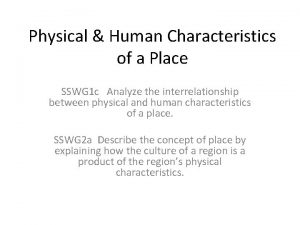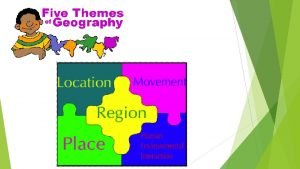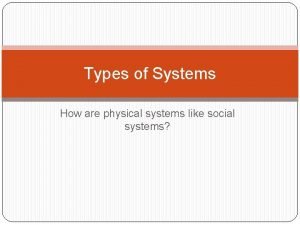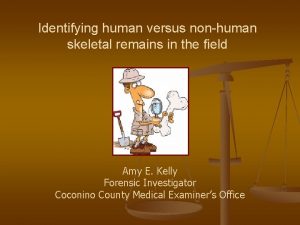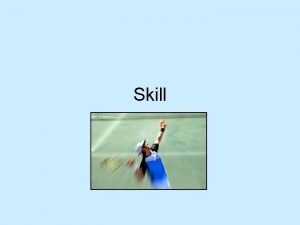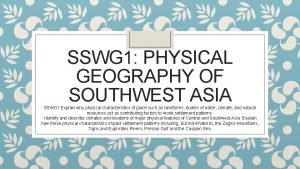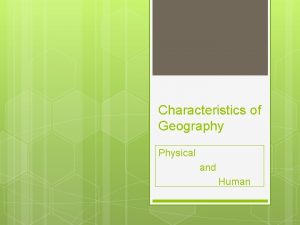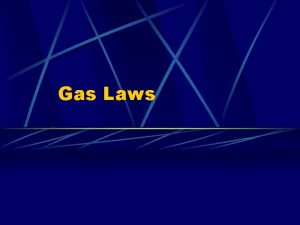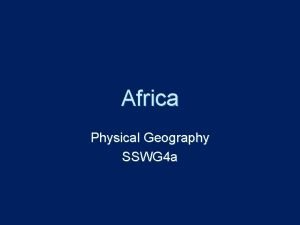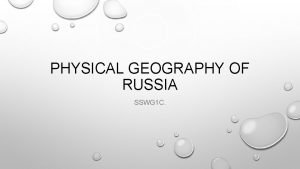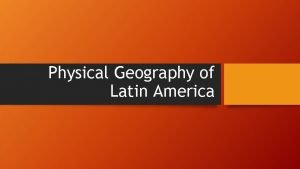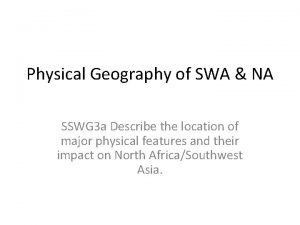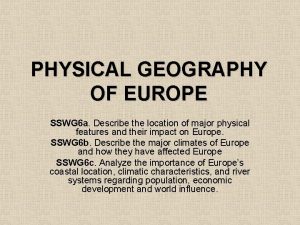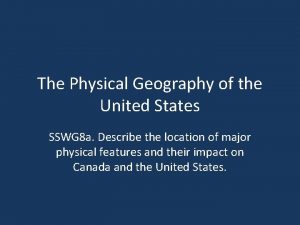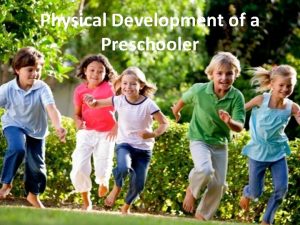Physical Human Characteristics of a Place SSWG 1



















- Slides: 19

Physical & Human Characteristics of a Place SSWG 1 c Analyze the interrelationship between physical and human characteristics of a place. SSWG 2 a Describe the concept of place by explaining how the culture of a region is a product of the region’s physical characteristics.

Physical Geography • Examples of Physical Characteristics shaping a place: – – – Landforms & Bodies of Water Climate Vegetation Soil Animal Life Natural Hazards

Landforms & Bodies of Water • There are many different types of landforms and bodies of water that present challenges • How would living here impact your job? Justify your answer.

Climate • Climate is the weather over a period of time. • Wind patterns, ocean currents, elevation, & landforms impact climate. • How would your life be affected if this was your climate daily? Once a year?

Soil • Soil is a thin layer of weathered rock, humus (decomposition), air and water • Soil can change because of erosion, farming, & grazing. • What can you infer about the soil in this place? Justify your answer.

Natural Vegetation • Vegetation is the plant life of a particular place. • People often change the vegetation to survive. • What kind of climate would support this kind of vegetation?

Animal Life • Animal life includes species indigenous to the region and domesticated animals. • What would be a positive of living here? Negative?

Natural Hazards • Examples – – – Volcanoes Earthquakes Hurricanes Typhoons Cyclones Tsunamis • Why do you think people still choose to live in places with natural hazards? Justify your answer.

Cultural Characteristics • Examples of Cultural Characteristics shaping a place: – – – – Language Customs & Traditions Religions Gender roles/Family Structures The Arts Foods Clothing Housing

Language • Language is expressed in both written & spoken form. • Isolation & globalization influence language. • What language would you expect to be spoken in this picture? Why?

Customs & Traditions • Customs & traditions are practices of a culture handed down from generation to generation. • Examples – Life cycle (birth, marriage, death) – Holiday – Seasons • What tradition do you think these women are celebrating? Justify your answer.

Religion • Religion is the belief in the creation and cause of the universe; usually supernatural • Major world religions & tribal religions • How might the belief in a religion impact your daily life? Give 3 examples.

Gender Roles/Family Structures • More developed countries have more equality between genders • Less developed countries have more traditional family structures. • Gender roles/family structures influence view on education and government participation • What can you infer about the gender role & family structure of the society ?

The Arts • The arts include – Music – Dance – Visual Arts • The arts are often linked to religion. • Could this boy’s painted face be considered to be art? Why or why not?

Foods • Food is heavily influenced by: – Landforms/Bodies of water – Religion – Standard of living • What can you infer about the diets of the people where this woman lives? Justify your answer.

Clothing • Clothing is often linked to the environment (climate) • Clothing can be linked to religion and/or gender roles. • What do you think the purpose of this clothing is? What does it tell you about the society?

Housing • Housing choices are linked a great deal with the physical environment (climate & building materials). • What factor(s) probably influenced the people here? Why? Justify your answer.

Post-It Gallery Walk • Now that you have learned all about the human and physical characteristics of a place you are going to show what you know. • In a moment you are going to work with other people (I am choosing so deal) and talk about how these factors are seen in the pictures in the room. • You will need a pen/pencil. • We will do the example together…

 Russia 5 themes of geography
Russia 5 themes of geography Human characteristics of place
Human characteristics of place Place physical characteristics
Place physical characteristics River nile map
River nile map Millions billions trillions chart
Millions billions trillions chart Is a disturbance that transfers energy from place to place
Is a disturbance that transfers energy from place to place A disturbance that transfers energy from place to place
A disturbance that transfers energy from place to place What is the central place theory
What is the central place theory Pricing strategies in marketing
Pricing strategies in marketing Physical activity and physical fitness assessments grade 9
Physical activity and physical fitness assessments grade 9 Compare india and sri lanka on the basis of hdi
Compare india and sri lanka on the basis of hdi Hmsweb
Hmsweb Human made social systems
Human made social systems Human vs non human bones
Human vs non human bones Cna chapter 8 human needs and human development
Cna chapter 8 human needs and human development Chapter 8 human needs and human development
Chapter 8 human needs and human development Gni definition ap human geography
Gni definition ap human geography Human and non human nouns
Human and non human nouns Meerkat physical characteristics
Meerkat physical characteristics Physical abilities and characteristics examples
Physical abilities and characteristics examples

